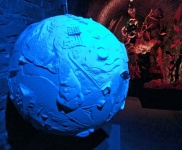
“Dark Garden” Presentation
“Dark Garden” is an installation I created that addresses environmental issues.
Normally a garden is a place of beauty and refuge that draws us in, but this somber garden of clay plant forms uses a suggestion of beauty as a “come on.” Closer inspection reveals problematic influences. The tall flowers have graffiti, broken antennas, barbed wire, caged birds, skeletons, insects, leaves infested with cars, and actual nails and bolts fired into the clay. The clay slabs from which these forms grow appear to be made of fossilized trash and computer parts.
In the center of the installation is a large round white sphere which can be read as a planet, a moon, or the Earth. It appears to be composed of trash. The trash theme in my work is used to symbolize the larger, more serious problems of pollution that threaten our planet. While littering may only be visually unappealing in the landscape, it is also a manifestation of a non-caring mentality that crosses the line toward doing actual harm, as it moves along the spectrum from plastic cups to carbon emissions and beyond. Littering is the canary in the coal mine.
The installation reflects our culture’s ambiguous relationship toward nature. I like to test the borders of response: what people want to see when nature is used as a subject, versus what they don’t want to see, playing with our acceptance or avoidance of environmental issues.
If “art is the replacing of indifference with attention,” then “Dark Garden” and its environmental subject matter needs continued exposure. The Puffin Grant enabled me to print and distribute promotional materials for “Dark Garden” when it was shown at the National Council on Education for the Ceramic Arts (NCECA) conference in Providence, RI in March 2015 and at the Erie Art Museum for the year of 2016. I hope that through promoting this sculpture to a broad audience I can bring attention to questions about what our society values and the effect of those values on the environment.
